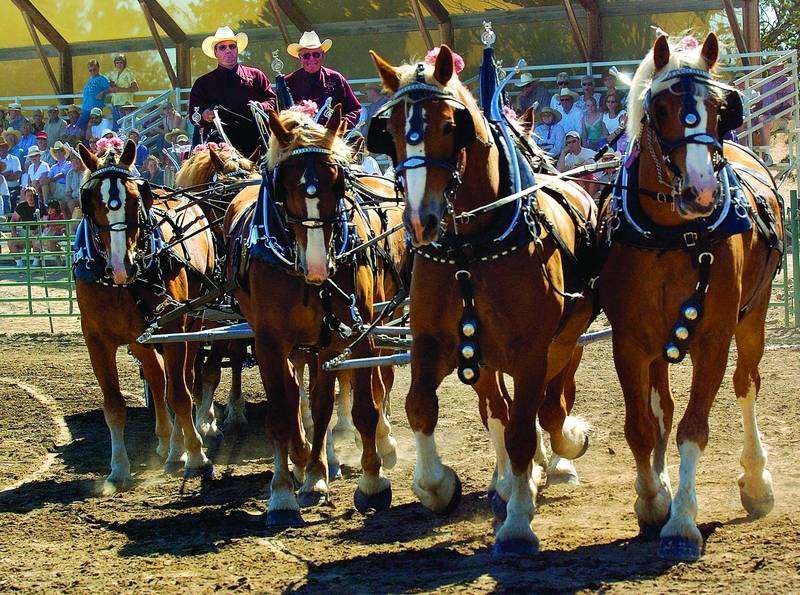It’s a ton of entertainment
Published 5:00 am Friday, July 7, 2006

- Mike McIntosh of Terrebonne drives the Lazy M Ranch eight-horse team during the 2005 Central Oregon Invitational Draft Horse Show at Eagle Crest Resort in Redmond. Belgians from Lazy M Ranch and draft horse breeds from 13 other Northwest farms and ranches are expected to compete at this year's show, which begins with an evening contest on Friday, July 14.
Driving competitions of all kinds – from log pulls to two- through eight-horse hitch – will showcase nearly every breed of draft horse next weekend at the 16th annual Central Oregon Invitational Draft Horse Show.
This year’s three-day event, which is expected to draw some 100 draft horses from 14 Northwest ranches, includes performances on Friday, Saturday and Sunday, July 14-16, staged at the equestrian arena at Eagle Crest Resort near Redmond.
The invitational displays different draft horse talents each day. Perhaps one of the most spectacular of the weekend’s 15 classes is the eight-horse hitch on Sunday, says event organizer Jeanne Lorenz.
”It’s eight horses hitched to the wagon, and on average these horses weigh 1,800 to 2,200 pounds,” explains Lorenz, adding that a driver controls his or her eight-ton team with just eight leather reins.
Teams dressed in ornate harnesses and pulling classic carts or wagons will be judged at the walk and trot in each direction around the show ring, after which drivers and their steeds line up in the center of the arena. There, the drivers move their team backward.
”The judges want to see how straight (the teams) back and how well they listen to commands,” notes Lorenz.
In the six-horse competition, drivers will be required to perform a movement called ”docking” the wagon, to demonstrate how the team can back up to a specific unloading area, as if they were delivering goods.
Teams are then tested with a maneuver called ”fanning the hitch,” in which the wagon must remain perfectly still while the horses move to the left and right of the hitch.
A number of equestrian demonstrations will also take place during the show, including performances by the Silver Edge Drill Team of Terrebonne, Bend’s Healing Reins Therapeutic Riding Center, and the Crazy Eights, a high-speed Shetland pony act. A musical freestyle dressage performance featuring a Friesian gelding and Lusitano stallion is also scheduled for each day during the event.
Among the local teams set to compete next weekend at the draft horse show is Sisters View Clydesdales of Redmond.
”It was started originally as more like a schooling show,” says Jinny Andres, whose teams of black Clydesdales have participated in the Central Oregon Invitational since its inception. ”But it became so popular with the exhibitors that it became one of the best shows on the West Coast.
”It shows all the major draft horse breeds. You don’t find that at all draft horse shows,” Andres observes. ”It shows examples to the spectators of most of the different hitches that have been used over the years. If you came all three days you would see great variety.”
Andres says the Clydesdale breed originated in Scotland, is characterized by white ”feathers” on its legs and possesses a naturally high step. The most common Clydesdale is bay in color (reddish-brown coat with black mane and tail). Andres notes that the Sisters View ranch is one of only a few in the country to breed the black variety of Clydesdale.
”It’s harder to breed them,” says Andres. ”You have to keep them out of the sun to keep them nice and black. (Horses that are part of the show hitch) go out at night and stay in during the day to keep their black color.”
Another rare breed of draft horse will be making an appearance at the three-day event. Carol Pshigoda raises the once nearly extinct American Cream at her Alfalfa ranch.
Creams are golden, similar to a palomino-colored horse, and are born with pink skin and white eyes, says Pshigoda.
”By 1 year old, their eyes turn to (the color of) amber,” she adds.
Standing at 15.2 to 16.3 hands high, American Creams are not as tall as their European draft horse cousins, which can stand 17 to 18 hands (a hand is four inches) and weigh up to 400 pounds more than the American breed.
Pshigoda says only 20 American Creams were known to exist in the United States during the 1980s. She explains that the breed was established near the turn of the 19th century, and in 1925 some 98,000 Creams were working American farms. However, with the invention of the tractor, many of the horses were slaughtered when they were no longer needed.
”I’m learning every day,” says Pshigoda, whose efforts to revive the breed began in the mid-1980s. She estimates that now there are approximately 500 American Creams in existence.
”They’re so rare,” she says. ”We’re still writing the history on how they grow.”
Pshigoda, who believes that her six-up – or six-hitch – team at the 2006 Eagle Crest show will be the first of its kind since the 1940s, says her fleet of draft horses aren’t just for show.
”The only chores our horses do not do is bale and bring in the hay,” says Pshigoda, who raises timothy orchard grass on her farm east of Bend. ”They rake, they mow, they plow. They do every other chore that the horse can do.”
By competing with her American Creams at events such the Central Oregon Invitational Draft Horse Show next weekend, Pshigoda hopes to attract more public awareness to the breed and its history.
”That’s the only way I can ensure I can save them from extinction,” she says.






